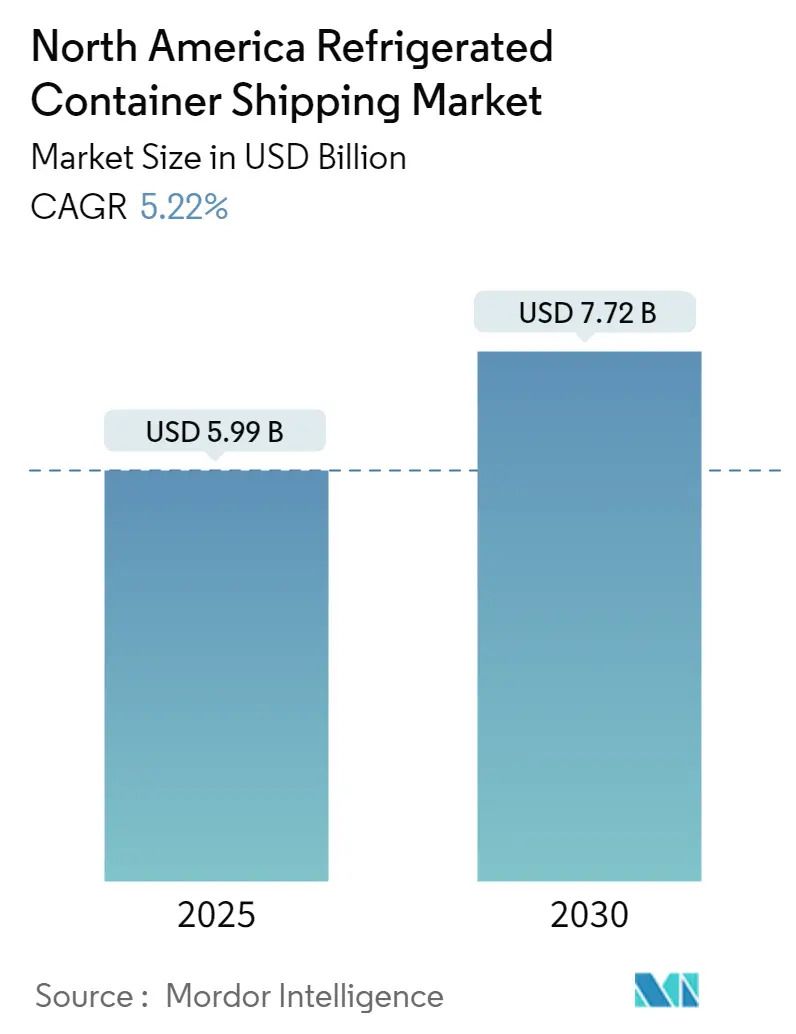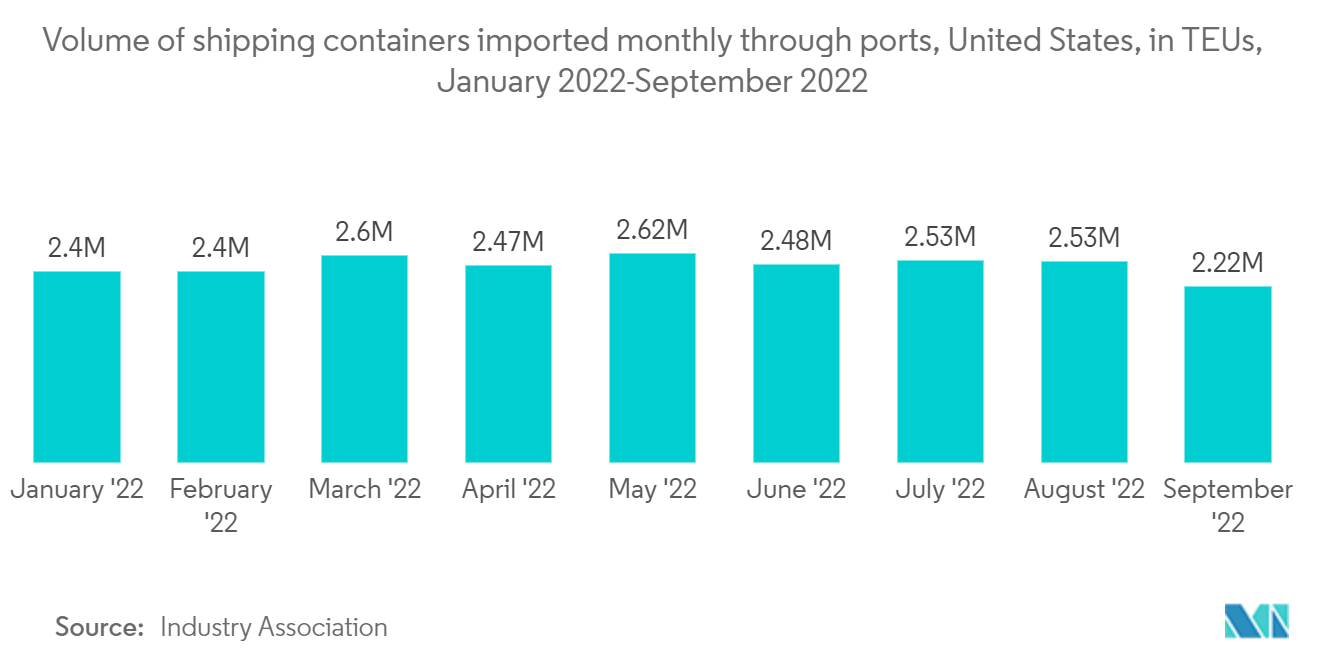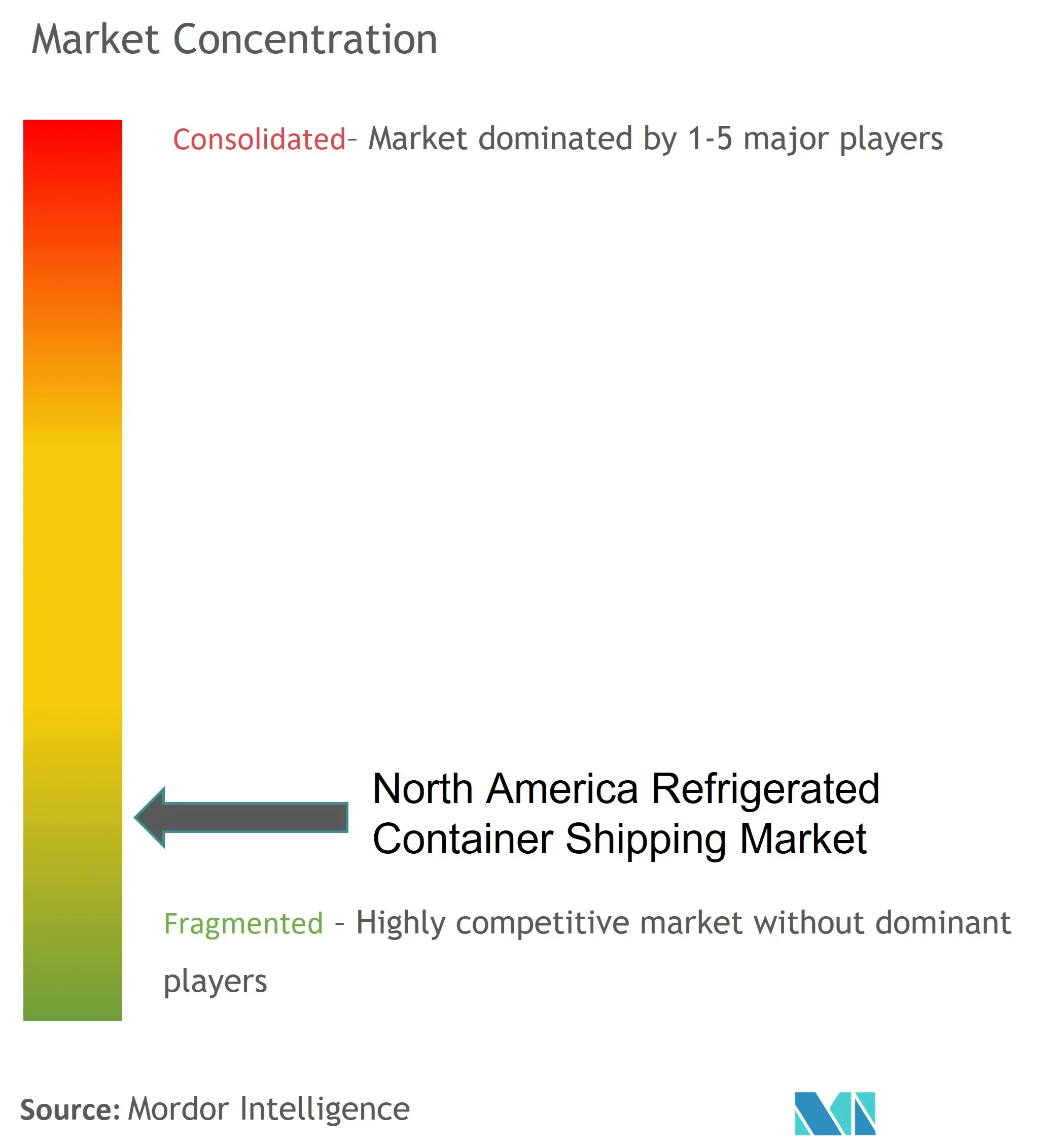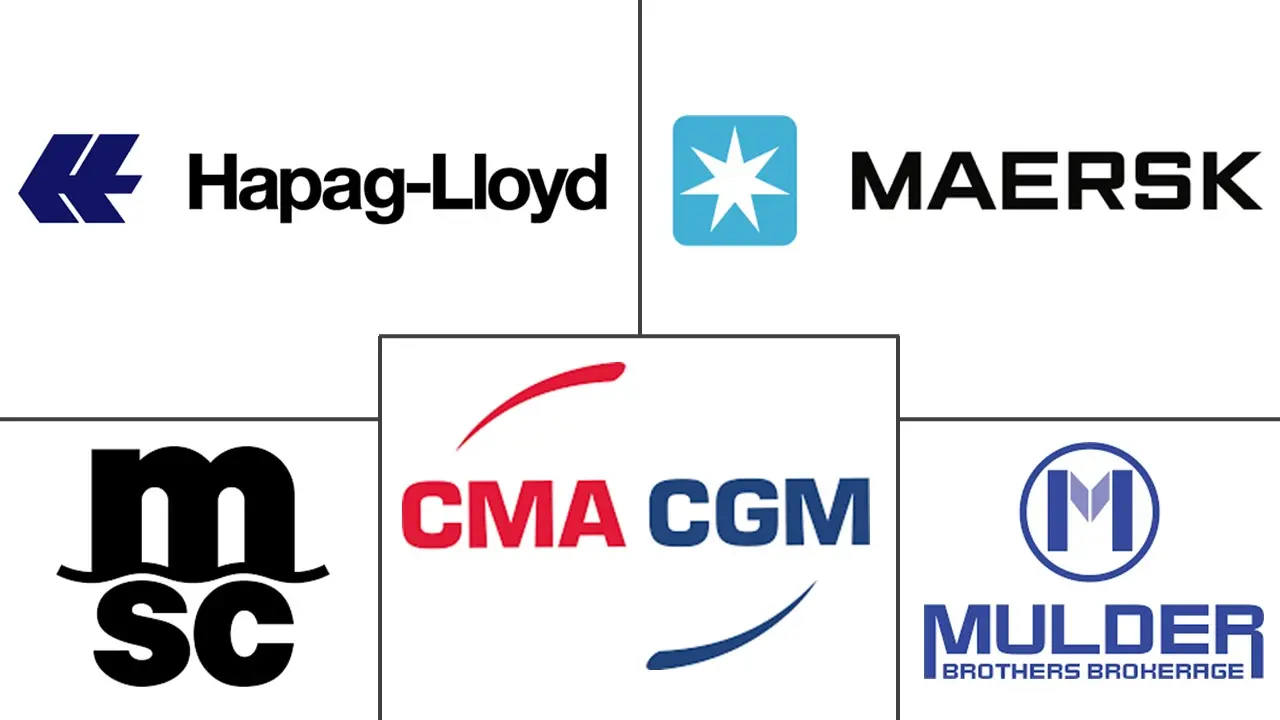North America Refrigerated Container Shipping Market Size and Share

North America Refrigerated Container Shipping Market Analysis by Mordor Intelligence
The North America Refrigerated Container Shipping Market size is estimated at USD 5.99 billion in 2025, and is expected to reach USD 7.72 billion by 2030, at a CAGR of 5.22% during the forecast period (2025-2030).
- The increasing demand from the agriculture, food, and beverage industries drives the market. Furthermore, the market is driven by the increasing demand from the pharmaceutical industry.
- Refrigerated transport refers to temperature-controlled cargo vehicles such as refrigerated trucks and shipping containers. These cars are equipped with an inbuilt cooling system that maintains the desired temperature throughout transportation. They frequently deliver food, such as fruits and vegetables, dairy, meat, and fish, as well as non-food items such as medications and flowers. These approaches serve to extend the shelf life of the product and ensure that seasonal commodities remain available all year. Refrigerated transport systems are insulated container systems that maintain temperature both actively and passively and are used for a variety of transportation. Even in tough circumstances, keeping the proper temperature settings aids in the preservation of product quality.
- Furthermore, although it is seasonal, it allows people globally to consume fruits and vegetables all year. Perishable items are transported from one site to another in a controlled environment utilizing a refrigerated transport service to retain quality and freshness and to prevent foodborne illness. Refrigerated transport became critical to the distribution process because the storage and preservation of food and raw materials during transportation necessitate controlled temperatures. The manufacture of temperature-sensitive pharmaceutical treatments, as well as expanding worldwide trade prospects, are further driving market growth. The adoption of cost-effective government laws and regulations covering product manufacturing, processing, transportation, and quality, as well as an increase in the usage of marine transport vehicles, are additional drivers expected to drive market expansion.
- In the trucking industry, the annual harvesting season in the United States usually means capacity and pricing issues. The annual harvest of fresh fruits and vegetables as the growing season shifts from south to north is known as the produce season. Because capacity migrates to follow the harvest and distribution, there is regional pressure on refrigerated and dry van capacity during the harvest. The produce season in 2023 is unlikely to present the usual capacity and pricing issues. Today's transportation industry is oversupplied since the market did not yet cut truckload capacity much. It means that the sector is prepared to serve the early harvest months in Florida and Georgia.
- Harvest season holds an impact on both the temperature-controlled trucking and dry van markets. When they are unable to obtain a load requiring refrigeration, refrigerated trucks compete in the dry van market. As the harvest season puts a strain on active refrigerated capacity, trucks leave the dry van sector to handle the increasing freight volume from fresh products. This movement essentially removes capacity from the dry van market, causing some regional conflict. Refrigerated trucking as a whole does not service fresh produce, putting some pressure on a sub-segment of refrigerated trucking. It is not represented in broad spot market data that covers all temperature categories. Many refrigerated carriers provide services in the temperature control and product categories.
North America Refrigerated Container Shipping Market Trends and Insights
Increase in demand from agriculture and pharmaceuticals industry
- 2023's summer and autumn, fresh-market vegetable crops in California, Florida and Mexico were plagued with a variety of inclement weather, which limited supplies and contributed to increased shipping-point prices. Fresh vegetable shipping-point costs are likely to continue above seasonal norms until new or replanted fields are harvested in late December 2022 or early January 2023. Growers of vital winter foods such as tomatoes, bell peppers, and squash in Florida were forced to rebuild fields after Hurricanes Ian and Nicole. Long-term drought, above-average temperatures, an unusual late summer downpour, and high pest pressure chopped into marketable fall-season supplies of green and cruciferous vegetables in California. Mexico (an important supply of winter fresh veggies such as tomatoes, peppers, squash, and green beans), hurricanes impacted growers in Western and North Central production regions.
- The 2022 crop is the first time that yearly potato production dropped for 5 years in a row. Despite increasing planted acres in 2019 and 2021, productivity gradually declined over the last few growing seasons. According to the USDA's November Crop Output report, 2022, US potato output is down 3% from last year, owing to lower planted acres (down 2%) and poor growing conditions. The season-average price (including fresh and processed potatoes) achieved a nominal record high of USD 10.20 per hundredweight during the September 2021-August 2022 marketing year, marking the first time the season price topped USD 10 per hundredweight.
- The United States accounts for around 45% of the worldwide pharmaceutical market and 22% of global output. The continuous global vaccination rollout and pent-up demand for necessary and non-essential medical treatments propeled the US pharmaceutical output and sales in 2022. While immunizations were driving the sector development in 2022 and 2023, an aged population will increase medicine demand in the medium and long term. The Supreme Court's decision to maintain the Affordable Care Act (Obamacare) also bodes well for the industry's future growth prospects. However, when the pandemic was over, legislative pressure to cut healthcare expenses might rise again. Given the high R&D expenses for producers, this could impact the investment.

Increase in demand for container shipping driving the market
- Port delays, labor shortages, inflation, and worldwide conflicts all altered how retailers ship and deliver items to customers. Several developing shipping concepts already taken hold and made their way into mainstream retail as of 2022: digitized supply chains, load balancing, and outsourcing fulfillment to a 3PL. Retailers who wish to optimize their operations should look into shipping patterns that are relevant to their business. Following the pandemic, businesses were dealing with both new and old shipping issues while attempting to meet customer demand. However, shipping delays and supply chain issues appear to be resolved by 2023.
- After years of rising transportation costs, businesses are now finding some respite. The current global average cost of shipping a container is USD 3,429, according to the Freightos Baltic Index, compared to USD 10,396 in October 2021. Carrier profits are expected to fall by up to 80% by 2024 when additional containers ordered during the pandemic become available, boosting capacity by up to 20% over the next two years. However, rates are unlikely to revert to pre-pandemic levels as long as the Russia-Ukraine war raises fuel prices.

Competitive Landscape
The North America Refrigerated Container Shipping Market is highly fragmented, with a lot of local, regional, and global players. Some of the major players include Mediterranean Shipping Company (MSC), A.P. Moller–Merks, CMA-CGM, Hapag-Lloyd, Mulder Brothers, and many more. The sector is observing many innovative and digital trends in recent years, like adopting big data analytics and IoT technologies to further fuel the growth of the chemical logistics industry.
North America Refrigerated Container Shipping Industry Leaders
Mediterranean Shipping Company (MSC)
A.P. Moller – Maersk
CMA-CGM
Hapag-Lloyd
Mulder Brothers
- *Disclaimer: Major Players sorted in no particular order

Recent Industry Developments
- March 2023: Maersk introduces an API-enabled reefer system with a shareable datalog. Moving perishable commodities around the world is a difficult task, especially when it comes to cargo like fruits, meat, and medication. These are susceptible to changing transit conditions. Maersk's refrigerated containers - equivalent to hundreds of thousands of units - are connected to Maersk's Remote Container Management system. It tracks the conditions within the reefers to ensure ideal conditions for moving sensitive cargo from A to B.
- February 2023: The Port of Savannah will build seven container racks in its Garden City Terminal to increase available refrigerated and frozen warehouse space by 11% to more than 2.2 million sq ft by 2023. According to a port press statement, the project, which was approved in late January, is priced at USD 6.2 million and will add 3,506 berths to the terminal.
North America Refrigerated Container Shipping Market Report Scope
Refrigerated containers, often known as reefer containers, are used to convey commodities that require temperature control during transit. Reefer containers are outfitted with a refrigeration unit that is powered by the ship's power source. A complete background analysis of the North America Refrigerated Container Shipping market, including the assessment of the economy and contribution of sectors in the economy, a market overview, market size estimation for key segments, emerging trends in the market segments, market dynamics, and geographical trends, and COVID-19 impact, is covered in the report.
The North America Refrigerated Container Shipping market is segmented by size (small container (20 ft), large container (40 ft), and high cube container), and country (United States, Canada, and Mexico). The report offers market size and forecasts in values (USD) for all the above segments.
| Small Container (20 Feet) |
| Large Container (40 Feet) |
| High Cube Container |
| United States |
| Canada |
| Mexico |
| By Size | Small Container (20 Feet) |
| Large Container (40 Feet) | |
| High Cube Container | |
| By Country | United States |
| Canada | |
| Mexico |
Key Questions Answered in the Report
How big is the North America Refrigerated Container Shipping Market?
The North America Refrigerated Container Shipping Market size is expected to reach USD 5.99 billion in 2025 and grow at a CAGR of 5.22% to reach USD 7.72 billion by 2030.
What is the current North America Refrigerated Container Shipping Market size?
In 2025, the North America Refrigerated Container Shipping Market size is expected to reach USD 5.99 billion.
Who are the key players in North America Refrigerated Container Shipping Market?
Mediterranean Shipping Company (MSC), A.P. Moller – Maersk, CMA-CGM, Hapag-Lloyd and Mulder Brothers are the major companies operating in the North America Refrigerated Container Shipping Market.
What years does this North America Refrigerated Container Shipping Market cover, and what was the market size in 2024?
In 2024, the North America Refrigerated Container Shipping Market size was estimated at USD 5.68 billion. The report covers the North America Refrigerated Container Shipping Market historical market size for years: 2019, 2020, 2021, 2022, 2023 and 2024. The report also forecasts the North America Refrigerated Container Shipping Market size for years: 2025, 2026, 2027, 2028, 2029 and 2030.
Page last updated on:
North America Refrigerated Container Shipping Market Report
Statistics for the 2025 North America Refrigerated Container Shipping market share, size and revenue growth rate, created by Mordor Intelligence™ Industry Reports. North America Refrigerated Container Shipping analysis includes a market forecast outlook for 2025 to 2030 and historical overview. Get a sample of this industry analysis as a free report PDF download.



